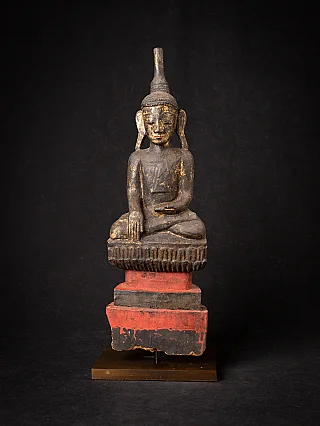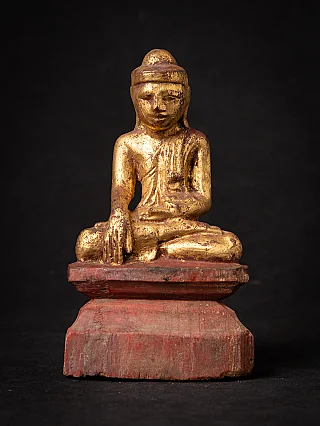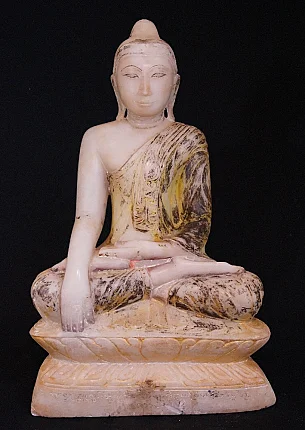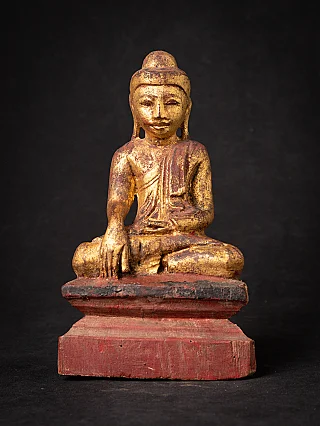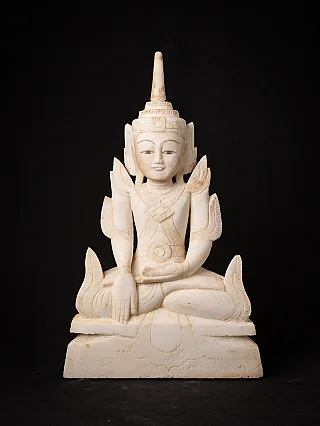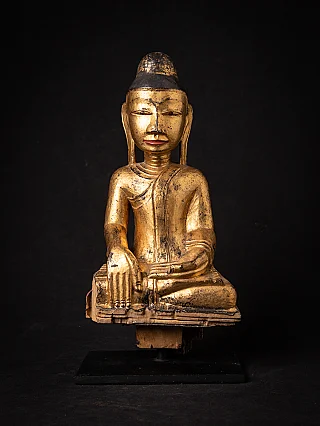Buddhist Traditions: Comprehensive guide to its rich traditions
Author : Peter Vredeveld

One of a kind statues from our private collections
Buddhism, practiced by over 500 million people globally, offers a profound path for overcoming suffering and attaining enlightenment. It originated in India in the 5th century BCE with the teachings of Siddhartha Gautama, who became known as the Buddha. His teachings on the Four Noble Truths and the Eightfold Path form the foundation of Buddhism. Over centuries, Buddhism has blossomed into a vibrant tapestry of traditions practiced across Asia, each with unique interpretations and practices. While core beliefs bind them together, these traditions reflect the diverse cultures and histories where they flourished.
Theravada Buddhism: The Path of the Elders

Theravada, meaning "School of the Elders," is the oldest surviving tradition of Buddhism. It strictly follows the Pali Canon, believed to be the closest representation of the Buddha's teachings. Originating in India, Theravada spread to Sri Lanka, Thailand, Myanmar, Laos, and Cambodia.
Core Philosophy and Practices
Theravada emphasizes personal effort in achieving enlightenment, primarily through monastic life and meditation practices. Vipassana (insight meditation) and Samatha (tranquility meditation) are central practices to develop mindfulness and concentration.
Historical Development
Theravada's development was marked by the formation of the Tipitaka (Pali Canon) and the establishment of monastic communities (Sangha). Missionary efforts and royal patronage facilitated the spread of Theravada to Southeast Asia.
Social Engagement
Theravada societies, including the monastic community, traditionally emphasize social order and respect for authority. Laypeople engage in merit-making activities to support the Sangha and accumulate good karma on their path to enlightenment. This social structure has played a significant role in shaping the cultural landscape of Southeast Asia.
Artistic Expressions
Theravada art includes the creation of Buddha statues, stupas (reliquary monuments), and murals depicting the life of the Buddha. These artistic forms serve both devotional and educational purposes, helping to communicate the teachings and inspire practice.
Mahayana Buddhism: The Great Vehicle

Mahayana, literally "Great Vehicle," emerged around the 1st century CE as a movement that sought to expand the scope of Buddhist practice to include all beings. It introduced the concept of the Bodhisattva, a compassionate being who postpones their nirvana to guide others. Mahayana Buddhism spread from India to China, Korea, Japan, Vietnam, and Tibet.
Core Philosophy and Practices
Mahayana Buddhism emphasizes the potential for all beings to achieve Buddhahood. Critical practices include cultivating Bodhicitta (the aspiration to achieve enlightenment for the benefit of all beings) and practicing the Six Perfections (paramitas).
The Bodhisattva Ideal
The ideal Bodhisattva embodies qualities like compassion (karuna), wisdom (prajna), skillful means (upaya), and courageous perseverance (virya). Mahayana scriptures depict a vast pantheon of Buddhas and Bodhisattvas, each representing different aspects of enlightenment and offering guidance on the path. Popular figures include:
- Amitabha Buddha (associated with Pure Land Buddhism).
- Avalokiteshvara (the embodiment of compassion).
- Manjusri (the embodiment of wisdom).
Philosophical Texts
Mahayana Buddhism is rich in philosophical texts that delve deeper into the nature of reality and the path to enlightenment. These texts include:
- Prajnaparamita Sutras (Perfection of Wisdom): These influential sutras explore the concept of shunyata (emptiness), challenging the notion of inherent self and emphasizing the interconnected nature of reality.
- Lotus Sutra: This Mahayana scripture emphasizes the potential for all beings to achieve Buddhahood and teaches the concept of "skillful means," where the Buddha adapts his teachings to the needs and capacities of different students.
Devotional Practices

Mahayana Buddhism places greater emphasis on devotional practices than Theravada. These practices offer laypeople accessible ways to connect with the Buddhas and Bodhisattvas and cultivate merit on the path to enlightenment. Standard devotional practices include:
- Chanting: Chanting mantras and sutras is a central practice in Mahayana Buddhism. Chanting can be done individually or in groups, creating a sense of devotion and community. Popular chants include the Heart Sutra and the Namo Amida Butsu (in Pure Land Buddhism).
- Making Offerings: Offering flowers, incense, food, and water at temples or personal altars is a way to show respect to the Buddhas and Bodhisattvas. These offerings also symbolize generosity and letting go of attachment.
- Visualization: Visualizing Buddhas and Bodhisattvas in meditation can help practitioners connect with their qualities and strengthen their aspiration for enlightenment.
Artistic Expressions
Mahayana art reflects the vastness and richness of the tradition. East Asian Temples feature intricate sculptures and paintings depicting Buddhas, Bodhisattvas, and stories from Mahayana scriptures. Mandalas, intricate geometric diagrams representing the universe and the enlightened mind, are a prominent feature in Mahayana Buddhist art. Additionally, Mahayana artistic traditions incorporate performing arts like Buddhist music, dance, and drama to tell stories, convey teachings, and create a sense of awe and devotion.
Zen Buddhism: Meditation in Action
Zen Buddhism, a distinctive branch of Mahayana, originated in China as Chan Buddhism before spreading to Japan, Korea, and Vietnam. Zen is renowned for its emphasis on meditation (zazen) as the primary means to awakening. Unlike the analytical approach of Theravada meditation, Zen emphasizes direct experience and intuitive understanding.
Core Philosophy and Practices
Zen practitioners believe that enlightenment is not a destination but a present reality that can be awakened through focused attention and letting go of conceptual thinking.
Essential Elements of Zen Practice
- Zazen (Seated Meditation): Zen is the cornerstone of Zen practice. Practitioners sit quietly, focusing their attention on the breath. The aim is not to achieve a blank mind but to observe thoughts and sensations without judgment. Through consistent zazen practice, practitioners cultivate mindfulness, concentration, and a deeper understanding of the nature of reality.
- Koan Practice: Koans are paradoxical statements or questions used in Zen to challenge rational thinking and provoke deeper insight. There are no intellectual answers to koans; they are meant to be contemplated and experienced directly through meditation. Famous koans include "What is the sound of one hand clapping?" and "Mu (meaning ''nothing'' or ''nothing'')."
- Monastic Discipline: Zen monasteries are known for their rigorous discipline, simplicity, and focus on mindful living. Daily activities, from eating and cleaning to working in the garden, are performed with mindfulness and awareness. This disciplined lifestyle helps to create a conducive environment for meditation practice.
Artistic Expressions
Zen art emphasizes simplicity, naturalness, and capturing the essence of a moment. Calligraphy, ink paintings depicting nature, and rock gardens (karesansui) are prominent Zen artistic expressions. These minimalist art forms reflect Zen's focus on direct experience and letting go of attachment to form.
Pure Land Buddhism: Devotion to Amitabha

Pure Land Buddhism, another primary school within Mahayana, emphasizes faith and devotion to Amitabha Buddha, who presides over the Western Pure Land. In this paradise, beings can be reborn and easily attain enlightenment. Pure Land practitioners believe they can be reborn in this Pure Land through sincere devotion and recitation of Amitabha's name.
Core Philosophy and Practices
The central practice in Pure Land Buddhism is the recitation of Amitabha's name, known as "Nianfo" in Chinese or "Nembutsu" in Japanese. This practice is believed to generate merit and create a strong connection with Amitabha Buddha. Pure Land Buddhism offers an accessible path to enlightenment for laypeople who may not have the time or ability to engage in intensive meditation practices.
Key Texts and Figures
- The Three Pure Land Sutras: These foundational texts include the Amitabha Sutra, the Infinite Life Sutra, and the Contemplation Sutra. They describe the qualities of the Pure Land, the vows of Amitabha Buddha, and the practices leading to rebirth in the Pure Land.
- Honen and Shinran: In Japan, Pure Land Buddhism was popularized by the teachings of Honen (1133-1212) and his disciple Shinran (1173-1263). Honen emphasized the exclusive practice of Nembutsu, while Shinran taught the concept of "Shinji," or true entrusting, where practitioners rely entirely on Amitabha's vow.
Devotional Practices
Pure Land Buddhism greatly emphasizes devotional practices, providing an accessible and straightforward path to enlightenment for lay practitioners. These practices include:
- Chanting: The primary practice is reciting the name of Amitabha Buddha (Nembutsu). Devotees chant phrases like "Namu Amida Butsu" to cultivate faith and devotion.
- Visualization: Visualizing the Pure Land and the image of Amitabha Buddha during meditation or while chanting helps to strengthen the connection with Amitabha and inspires practitioners.
- Scripture Recitation: Reading and reciting Pure Land sutras, such as the Amitabha Sutra, is a devotional practice that helps deepen understanding.
Social Engagement
Its emphasis on community characterizes Pure Land Buddhism and lay participation. Temples often serve as centers for social and religious activities, providing communal chanting, meditation, and study opportunities. Laypeople play an active role in the life of the temple, supporting monastic communities and engaging in various forms of service.
Artistic Expressions
Pure Land art often depicts Amitabha Buddha, the Pure Land paradise, and scenes from the lives of Pure Land masters. These artistic representations aid meditation and devotion, helping practitioners visualize and connect with the Pure Land.
Vajrayana Buddhism: The Diamond Vehicle

Vajrayana, also known as Tantric or Esoteric Buddhism, is a unique branch of Mahayana that incorporates complex rituals, symbolism, and esoteric teachings to achieve rapid enlightenment. Vajrayana is predominantly practiced in Tibet, Bhutan, Nepal, and Mongolia.
Core Philosophy and Practices
Vajrayana emphasizes transforming ordinary experiences into the path of enlightenment. This tradition employs various practices, including visualization, mantra recitation, mudras (ritual gestures), and mandalas (sacred diagrams). The goal is to harness the subtle energies of the body and mind to realize the nature of reality directly.
Unique Practices
- Guru Yoga: This practice involves devotion to a spiritual teacher (guru) who is seen as a manifestation of enlightened qualities. Guru yoga helps practitioners receive blessings and guidance on the path.
- Deity Yoga: Practitioners visualize themselves as enlightened deities, embodying their qualities and actions. This practice helps to purify negative tendencies and develop positive qualities.
- Mantra Recitation: Reciting mantras, sacred syllables, or phrases invokes the power of enlightened beings and transforms the practitioner's mind. One of the most well-known mantras is "Om Mani Padme Hum," associated with Avalokiteshvara.
- Mandala Practice: Creating and meditating on mandalas, intricate geometric designs symbolize the universe and the enlightened mind. Mandalas are used in initiations and advanced meditation practices.
Historical Context
Vajrayana Buddhism developed in India around the 6th century CE and spread to Tibet in the 8th century. It was transmitted through lineages of teachers and students, and many influential figures, such as Padmasambhava, Atisha, and Tsongkhapa, contributed to its growth.
Artistic Expressions
Vajrayana art is renowned for its intricate thangka paintings, mandalas, and statues of deities and gurus. These artistic forms are not merely decorative but serve as meditation aids and representations of the enlightened mind.
Social Engagement
The relationship between lay practitioners and the monastic community is deeply interconnected in Vajrayana societies. Laypeople support monasteries through donations and service, while monks and nuns provide teachings, guidance, and rituals for the community's benefit. Festivals, traditions, and communal practices foster social cohesion and spiritual growth.
Conclusion
With its rich tapestry of traditions, Buddhism offers diverse paths to enlightenment. Theravada, Mahayana, Zen, Pure Land, and Vajrayana each present unique approaches, philosophies, and practices, reflecting the cultural and historical contexts in which they evolved. Despite their differences, these traditions share a common goal: the liberation from suffering and the realization of true wisdom and compassion.
By exploring these diverse traditions, practitioners can find inspiration and guidance on their spiritual journeys. Whether through the disciplined meditation of Zen, the compassionate practices of Mahayana, the holy faith of Pure Land, or the esoteric rituals of Vajrayana, Buddhism offers a wealth of wisdom and methods for cultivating a more enlightened and compassionate life.
Share this page



















